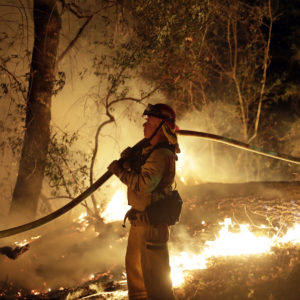The wildfire season in California has been over for months, but the process of rebuilding is just beginning. For utility companies and customers in the Golden State, recovering from the devastating fires of 2017 looks likely to be expensive. The issue is a particular concern for the Pacific Gas and Electric Company (PG&E), the state’s largest utility company, which faces liability costs likely in the tens of billions of dollars, a sum that could threaten the future of the company.
Fighting the 2017 wildfires was expensive. California state agencies spent nearly $1.8 billion fighting the fires. While the bulk of this money will be reimbursed by the federal government, about $371 million will need to come out of the state’s coffers. This is in addition to the state’s existing wildfire budget.
These expenses are dwarfed by the size of the economic damages caused by last year’s fires. Estimates for the total claims vary, but are generally in the neighborhood of $10 to $15 billion, with some observers suggesting that the numbers could go even higher. Unfortunately for PG&E, California state law passes a significant amount of this liability on to utility companies. As the largest utility company in the state, and the primary provider in the areas where the fires spread, PG&E is looking at a potentially crippling bill.
At present, state investigators are working to pinpoint the cause of last year’s deadly wildfires. In the meantime, property owners and even county governments affected by the fire are already suing for damages. California has unique state laws, which allow for property owners to collect higher damages from utility companies than they might in other states.
For PG&E, this could be an expensive set of state regulations. During the months since the fire, property owners and even some counties have sued PG&E for damages related to the fires. California is one of the few states to allow for inverse condemnation, which increases the liability risks of public utility companies.
“This means that if a utility’s equipment is found to have been a substantial cause of the damage in the event like a wildfire – even if the utility has followed established inspection and safety rules – the utility may be liable for property damages and attorneys’ fees associated with that event,” the company said in a statement after charges had been filed in January.
“Allowing essentially unlimited liability undermines the financial health of the state’s utilities, discourages investment in California and has the potential to materially impact the ability of utilities to access the capital markets to fund utility operations. All of these are bad for customers and bad for the state of California,” it continued.
PG&E is pushing back on the demands, fighting for the right to recover costs stemming from the wildfires “in the legal, regulatory and legislative arenas,” as CEO Geisha Williams said in February. The company has argued that the problem of wildfires is a broader issue affecting more than just utility companies and it is unfair for them to be given sole legal liability.
“It’s bigger than just PG&E and the other California IOUs, and much bigger than just this past year’s fires,” Williams said of the wildfires, connecting them to climate change. “This is a collective societal challenge.”
The company argues that without relief from the wildfire liability, it will become “uninvestible” because state law would effectively make utility companies the default insurers for wildfire risk. PG&E carries $800 million in liability insurance, far less than the liability costs it faces.
The situation has already led some to pronounce the death of investor owned utilities in the state. At the end of February, California Public Utilities Commission head Michael Picker deigned to describe the situation as a crisis, but said that he thought the state was moving towards bankruptcy for certain types of utilities. Picker noted that declining credit ratings, like those caused by the recent wildfires, would both threaten the companies’ financial health and make it more difficult for them to access needed capital in the future.
This question of who should bear the costs for the additional risks of running power lines and installing transformers in remote areas that might be wooded or filled with dry underbrush has been a major topic of debate. One suggested solution is to charge people living in rural areas different for their electricity, on the grounds that these parts of the state are at a higher fire risk.
“Should we actually start to charge differentially for the use of the distribution system for those sections that are in the high-fire-hazard zone and people who choose to live there?” asked Michael Picker, president of the California Public Utilities Commission during the commission’s January meeting.
While Picker’s question fell short of a formal proposal, he reiterated in later statements that the idea is worth exploring. It might offer a potential middle ground between saddling ratepayers across the state with the costs of the fire or handing the utility itself a potentially crippling bill. According to present estimations, the utility’s wildfire liability is seven times its 2016 pre-tax income. Cost recovery would allow the company to recover some of these costs at a more minor cost to individual customers or investors.
Already, the wildfire liabilities are rattling investors. At the beginning of March, Fitch downgraded the utility’s rating, following a similar move by Standard & Poor’s. The company also halted dividend payments in December, prompting a stock price fall.

